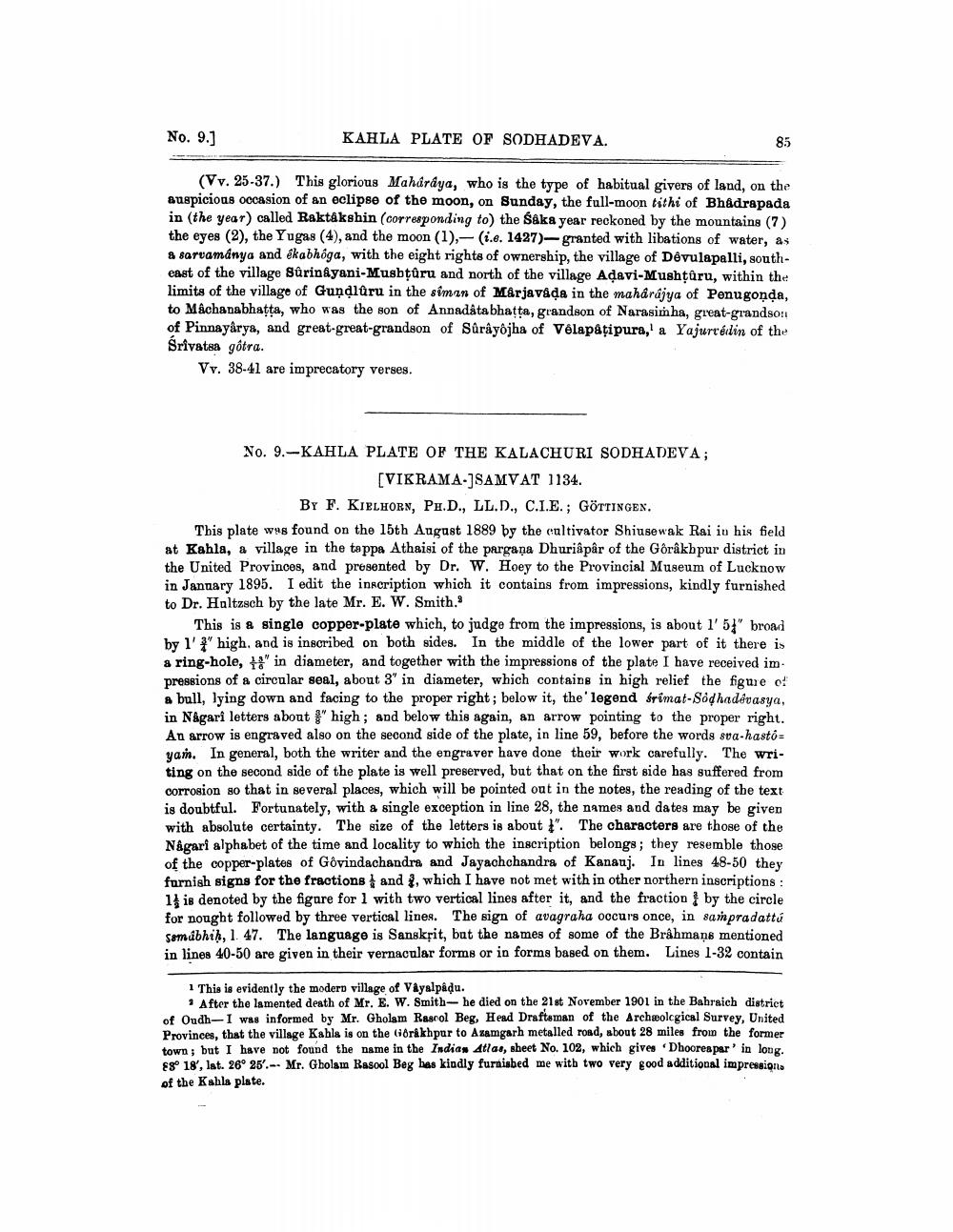________________
No. 9.]
KAHLA PLATE OF SODHADEVA.
(Vv. 25-37.) This glorious Mahardya, who is the type of habitual givers of land, on the auspicious occasion of an eclipse of the moon, on Sunday, the full-moon tithi of Bhadrapada in (the year) called Raktákshin (corresponding to the Såka year reckoned by the mountains (7) the eyes (2), the Yugas (4), and the moon (1),- (ie. 1427)- granted with libations of water, as & sarvamanya and ekabhôga, with the eight rights of ownership, the village of Dêvulapalli, southeast of the village Sûrinkyani-Musbțuru and north of the village Adavi-Mushtūru, within the limits of the village of Gundluru in the simin of Marjavada in the maharajya of Penugonda, to Machanabhatta, who was the son of Annadáta bhatta, grandson of Narasimha, great-grandso! of Pinnaydrya, and great-great-grandson of Surayôjha of Vélapátipura,' a Yajurvédin of the Srivatsa gôtra.
Vy. 38-41 are imprecatory verses.
No. 9.-KAHLA PLATE OF THE KALACHURI SODHADEVA;
[VIKRAMA-]SAMVAT 1134.
BY F. KIELHORN, PH.D., LL.D., C.I.E.; GÖTTINGEN. This plate was found on the 15th August 1889 by the cultivator Shiusewak Rai in his field at Kahla, a village in the tappa Athaisi of the pargana Dhuriâpâr of the Gôråkbpur district in the United Provinces, and presented by Dr. W. Hoey to the Provincial Museum of Lucknow in January 1895. I edit the inscription which it contains from impressions, kindly furnished to Dr. Holtzsch by the late Mr. E. W. Smith.
This is a single copper-plate which, to judge from the impressions, is about 1' 5" broad by 1'" high, and is inscribed on both sides. In the middle of the lower part of it there is å ring-hole, " in diameter, and together with the impressions of the plate I have received im pressions of a circular seal, about 3' in diameter, which contains in high relief the figure of a bull, lying down and facing to the proper right; below it, the legend frimat-Sodhaddvasya, in Nagari letters about f" high ; and below this again, an arrow pointing to the proper right. An arrow is engraved also on the second side of the plate, in line 59, before the words sva-hastoyan. In general, both the writer and the engraver have done their work carefully. The writing on the second side of the plate is well preserved, but that on the first side has suffered from corrosion so that in several places, which will be pointed out in the notes, the reading of the text is doubtful. Fortunately, with a single exception in line 28, the names and dates may be given with absolute certainty. The size of the letters is about " The characters are those of the Nagari alphabet of the time and locality to which the inscription belongs; they resemble those of the copper-plates of Govindachandra and Jayachchandra of Kanauj. In lines 48-50 they furnish signs for the fractions and d, which I have not met with in other northern inscriptions : 1 is denoted by the figare for l with two vertical lines after it, and the fraction by the circle for nought followed by three vertical lines. The sign of avagraha occurs once, in sampradattá Somůbhih, 1. 47. The language is Sanskrit, but the names of some of the Brahmans mentioned in lines 40-50 are given in their vernacular forms or in forms based on them. Lines 1-32 contain
1 This is evidently the modern village of Vayalpadu.
1 After the lamented death of Mr. E. W. Smith-he died on the 21st November 1901 in the Bahraich district of Oudh- I was informed by Mr. Gholam Rasool Beg, Head Draftsman of the Archological Survey, United Provinces, that the village Kabla is on the Girikhpur to Azamgarh metalled road, about 28 miles from the former town, but I have not found the name in the Indian Atlas, sheet No. 102, which gives Dhooreaper' in long. Sg° 18'. lst. 26° 25'. -- Mr. Gholam Rasool Beg has kindly furnisbed me with two very good additional impressions of the Kahla plate.




